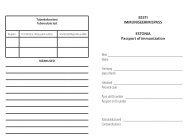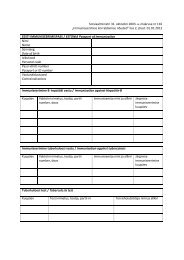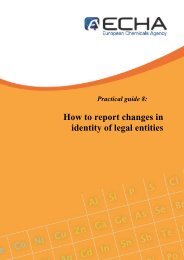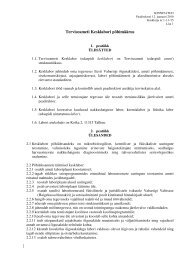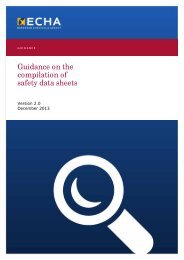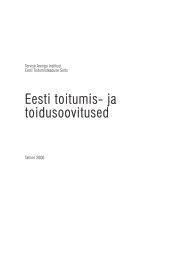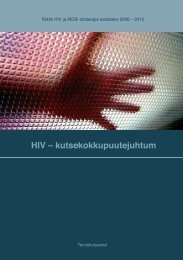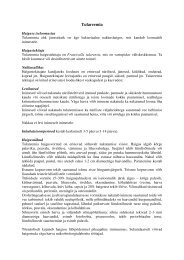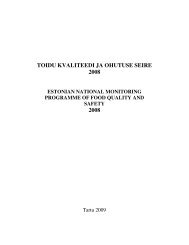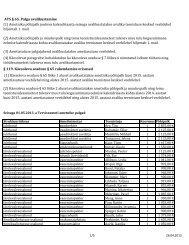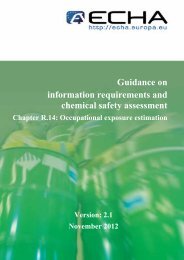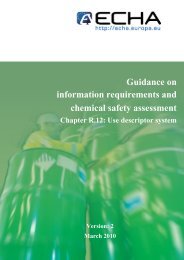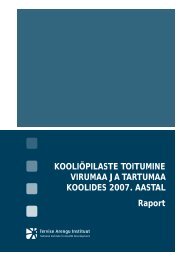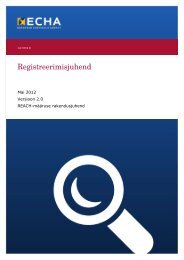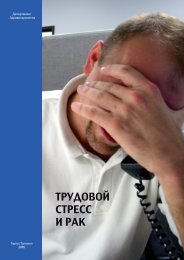Introductory Guidance on the CLP Regulation - ECHA - Europa
Introductory Guidance on the CLP Regulation - ECHA - Europa
Introductory Guidance on the CLP Regulation - ECHA - Europa
Create successful ePaper yourself
Turn your PDF publications into a flip-book with our unique Google optimized e-Paper software.
Basic guidance to Regulati<strong>on</strong> (EC) No 1272/2008 <strong>on</strong> Classificati<strong>on</strong>, Labelling and Packaging of substances and mixtures<br />
Testing for health and envir<strong>on</strong>mental hazards<br />
<strong>CLP</strong> does not oblige you to perform new testing. However, you may perform new<br />
testing provided that you have exhausted all o<strong>the</strong>r means of generating informati<strong>on</strong>,<br />
including by applying <strong>the</strong> rules provided for in secti<strong>on</strong> 1 of Annex XI to REACH (<strong>CLP</strong><br />
Article 8). These rules refer to <strong>the</strong> use of existing data, use of data from tests not<br />
carried out according to <strong>the</strong> principles of good laboratory practice, use of historical<br />
human data, applicati<strong>on</strong> of weight of evidence and use of (Q)SAR’s 4 , in-vitro methods<br />
and read-across. Expert judgement should be used in order to apply <strong>the</strong> criteria, for<br />
example to evaluate available test data that cannot be applied directly to <strong>the</strong> criteria or<br />
to exploit available data <strong>on</strong> mixtures which are similar to <strong>the</strong> <strong>on</strong>e to be classified (<strong>CLP</strong><br />
Article 9). Animal testing should <strong>on</strong>ly be undertaken when no o<strong>the</strong>r alternatives are<br />
available that provide adequate reliability and quality of data. New testing not<br />
involving animals may be performed where this warrants a more appropriate<br />
classificati<strong>on</strong>, e.g. in case of transformati<strong>on</strong>/dissoluti<strong>on</strong> testing for <strong>the</strong> aquatic hazard<br />
classificati<strong>on</strong> of metals and sparingly soluble metal compounds. Testing <strong>on</strong> humans is<br />
not allowed for <strong>the</strong> purposes of <strong>the</strong> <strong>CLP</strong> Regulati<strong>on</strong>. However, data obtained from<br />
clinical or epidemiological studies or scientifically valid case studies may be used.<br />
Testing <strong>on</strong> n<strong>on</strong>-human primates is prohibited (<strong>CLP</strong> Article 7).<br />
In general, any new testing shall be carried out in accordance with <strong>the</strong> test methods<br />
set out in Regulati<strong>on</strong> (EC) No 440/2008; alternatively, it can be based <strong>on</strong> sound<br />
scientific principles that are internati<strong>on</strong>ally recognised or <strong>on</strong> internati<strong>on</strong>ally validated<br />
methods.<br />
Testing shall be carried out <strong>on</strong> <strong>the</strong> substance or mixture in <strong>the</strong> form(s) or physical<br />
state(s) in which it is placed <strong>on</strong> <strong>the</strong> market and in which it can reas<strong>on</strong>ably be expected<br />
to be used (for fur<strong>the</strong>r guidance see Part 1.2 of Module 2). Moreover, new testing<br />
involving animals must be carried out in compliance with <strong>the</strong> principles of good<br />
laboratory practice and respect <strong>the</strong> rules of Directive 86/609/EEC. Normally, it will be<br />
necessary for you to outsource such testing.<br />
For mixtures, <strong>the</strong> same rules apply as for substances – where data are already<br />
available <strong>on</strong> <strong>the</strong> mixture as a whole, this should primarily be c<strong>on</strong>sidered. However, in<br />
relati<strong>on</strong> to <strong>the</strong> carcinogenic, mutagenic or toxic to reproducti<strong>on</strong> (CMR) properties of a<br />
mixture, <strong>the</strong> classificati<strong>on</strong> shall normally be based <strong>on</strong> <strong>the</strong> classificati<strong>on</strong> of <strong>the</strong><br />
ingredient substances, applying <strong>the</strong> relevant c<strong>on</strong>centrati<strong>on</strong> thresholds. Only in<br />
excepti<strong>on</strong>al cases you may use available test data <strong>on</strong> <strong>the</strong> mixture itself, i.e. where<br />
<strong>the</strong>se indicate CMR properties that have not been identified from <strong>the</strong> individual<br />
ingredient substances (<strong>CLP</strong> Article 6(3)). Mixture classificati<strong>on</strong> for <strong>the</strong> aquatic hazard<br />
taking account of biodegradati<strong>on</strong> and bioaccumulati<strong>on</strong> should be based <strong>on</strong> <strong>the</strong><br />
4<br />
(Q)SAR stands for qualitative or quantitative structure-activity relati<strong>on</strong>ship.<br />
48



